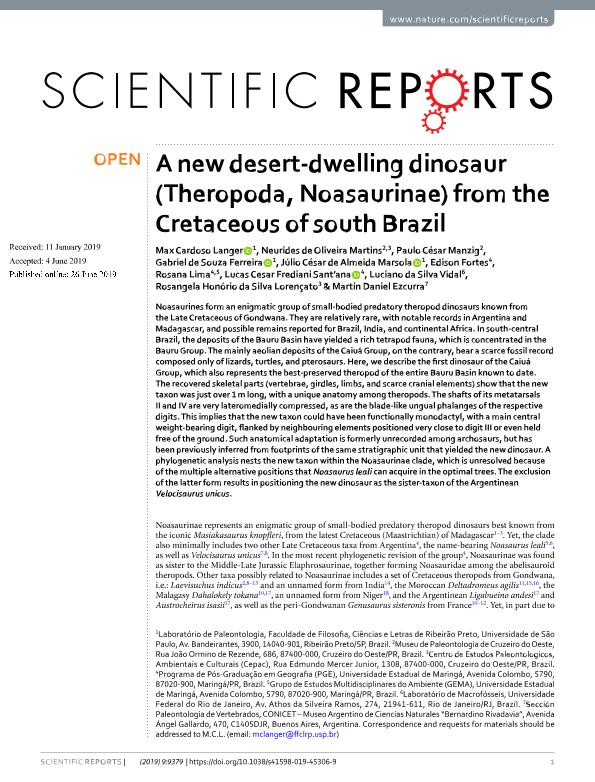Mostrar el registro sencillo del ítem
dc.contributor.author
Langer, Max Cardoso
dc.contributor.author
de Oliveira Martins, Neurides
dc.contributor.author
Manzig, Paulo César
dc.contributor.author
de Souza Ferreira, Gabriel
dc.contributor.author
de Almeida Marsola, Júlio César
dc.contributor.author
Fortes, Edison
dc.contributor.author
Lima, Rosana
dc.contributor.author
Frediani Sant'ana, Lucas Cesar
dc.contributor.author
da Silva Vidal, Luciano
dc.contributor.author
da Silva Lorençato, Rosangela Honório
dc.contributor.author
Ezcurra, Martin Daniel

dc.date.available
2021-03-01T17:20:23Z
dc.date.issued
2019-12
dc.identifier.citation
Langer, Max Cardoso; de Oliveira Martins, Neurides; Manzig, Paulo César; de Souza Ferreira, Gabriel; de Almeida Marsola, Júlio César; et al.; A new desert-dwelling dinosaur (Theropoda, Noasaurinae) from the Cretaceous of south Brazil; Nature Publishing Group; Scientific Reports; 9; 1; 12-2019; 1-31
dc.identifier.issn
2045-2322
dc.identifier.uri
http://hdl.handle.net/11336/127021
dc.description.abstract
Noasaurines form an enigmatic group of small-bodied predatory theropod dinosaurs known from the Late Cretaceous of Gondwana. They are relatively rare, with notable records in Argentina and Madagascar, and possible remains reported for Brazil, India, and continental Africa. In south-central Brazil, the deposits of the Bauru Basin have yielded a rich tetrapod fauna, which is concentrated in the Bauru Group. The mainly aeolian deposits of the Caiuá Group, on the contrary, bear a scarce fossil record composed only of lizards, turtles, and pterosaurs. Here, we describe the first dinosaur of the Caiuá Group, which also represents the best-preserved theropod of the entire Bauru Basin known to date. The recovered skeletal parts (vertebrae, girdles, limbs, and scarce cranial elements) show that the new taxon was just over 1 m long, with a unique anatomy among theropods. The shafts of its metatarsals II and IV are very lateromedially compressed, as are the blade-like ungual phalanges of the respective digits. This implies that the new taxon could have been functionally monodactyl, with a main central weight-bearing digit, flanked by neighbouring elements positioned very close to digit III or even held free of the ground. Such anatomical adaptation is formerly unrecorded among archosaurs, but has been previously inferred from footprints of the same stratigraphic unit that yielded the new dinosaur. A phylogenetic analysis nests the new taxon within the Noasaurinae clade, which is unresolved because of the multiple alternative positions that Noasaurus leali can acquire in the optimal trees. The exclusion of the latter form results in positioning the new dinosaur as the sister-taxon of the Argentinean Velocisaurus unicus.
dc.format
application/pdf
dc.language.iso
eng
dc.publisher
Nature Publishing Group

dc.rights
info:eu-repo/semantics/openAccess
dc.rights.uri
https://creativecommons.org/licenses/by-nc-sa/2.5/ar/
dc.subject
Dinosauria
dc.subject
Theropoda
dc.subject
phylogeny
dc.subject
Brazil
dc.subject.classification
Paleontología

dc.subject.classification
Ciencias de la Tierra y relacionadas con el Medio Ambiente

dc.subject.classification
CIENCIAS NATURALES Y EXACTAS

dc.title
A new desert-dwelling dinosaur (Theropoda, Noasaurinae) from the Cretaceous of south Brazil
dc.type
info:eu-repo/semantics/article
dc.type
info:ar-repo/semantics/artículo
dc.type
info:eu-repo/semantics/publishedVersion
dc.date.updated
2020-11-26T17:46:07Z
dc.journal.volume
9
dc.journal.number
1
dc.journal.pagination
1-31
dc.journal.pais
Reino Unido

dc.description.fil
Fil: Langer, Max Cardoso. Universidade de Sao Paulo; Brasil
dc.description.fil
Fil: de Oliveira Martins, Neurides. Museu de Paleontologia de Cruzeiro do Oeste; Brasil
dc.description.fil
Fil: Manzig, Paulo César. Museu de Paleontologia de Cruzeiro do Oeste; Brasil
dc.description.fil
Fil: de Souza Ferreira, Gabriel. Universidade de Sao Paulo; Brasil
dc.description.fil
Fil: de Almeida Marsola, Júlio César. Universidade de Sao Paulo; Brasil
dc.description.fil
Fil: Fortes, Edison. UNIVERSIDADE ESTADUAL DE MARINGÁ (UEM);
dc.description.fil
Fil: Lima, Rosana. UNIVERSIDADE ESTADUAL DE MARINGÁ (UEM);
dc.description.fil
Fil: Frediani Sant'ana, Lucas Cesar. UNIVERSIDADE ESTADUAL DE MARINGÁ (UEM);
dc.description.fil
Fil: da Silva Vidal, Luciano. Universidade Federal do Rio de Janeiro; Brasil
dc.description.fil
Fil: da Silva Lorençato, Rosangela Honório. Universidade Federal do Rio de Janeiro; Brasil
dc.description.fil
Fil: Ezcurra, Martin Daniel. Consejo Nacional de Investigaciones Científicas y Técnicas. Oficina de Coordinación Administrativa Parque Centenario. Museo Argentino de Ciencias Naturales "Bernardino Rivadavia"; Argentina
dc.journal.title
Scientific Reports
dc.relation.alternativeid
info:eu-repo/semantics/altIdentifier/url/http://www.nature.com/articles/s41598-019-45306-9
dc.relation.alternativeid
info:eu-repo/semantics/altIdentifier/doi/http://dx.doi.org/10.1038/s41598-019-45306-9
Archivos asociados
